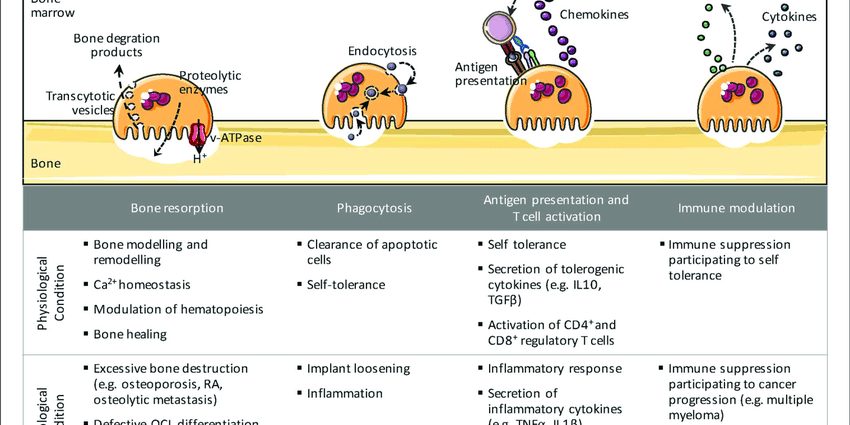Contents
What is the role of osteoclasts?
Bone is a rigid structure that contains minerals and collagen to together ensure its strength. Throughout life, bone grows, breaks, repairs itself, but also deteriorates. Bone remodeling is a complex process, which requires cooperation between osteoclasts and osteoblasts.
Anatomy of osteoclasts?
Bone tissue is made up of bone cells and a mineralized extracellular matrix, made up of collagen and non-collagenic proteins. The incessant restructuring of bone tissue is the result of the action of three types of cells:
- osteoclasts which continually destroy worn bone (bone resorption);
- osteoblasts which make the substances necessary to modify the missing element (bone formation);
- osteocytes.
This regeneration must be done in a balanced way and in a very precise order to guarantee the structure of the bone and guarantee its solidity.
Osteoclasts are therefore bone cells responsible for the resorption of bone tissue, and are involved in its renewal. Bone tissue resorption is the process by which osteoclasts break down bone tissue and release minerals, allowing calcium to be transferred from bone tissue to the blood. The osteoclasts thus deteriorate the bone substance.
When the bones are no longer stressed, the osteoclasts break down the calcified basic substance.
What is the physiology of osteoclasts?
Usually there is a “balance” between bone formation and resorption. The vast majority of skeletal diseases therefore come from an imbalance: either they dig too much, or they do not build enough, or it is a combination of these two mechanisms.
In addition, osteocytes can send the wrong signal. Too high hormone levels can also lead to increased bone destruction. This is why bone capital drops over the course of life:
- If the resorption is more intense than the formation: the bone mass decreases, leading to the loss of the mechanical properties of the bone and leading to fractures (osteoporosis or osteogenesis imperfecta);
- If the formation exceeds resorption: bone mass increases abnormally, which can lead to osteosclerosis.
Are there any anomalies, pathologies linked to osteoclasts?
Bone tissue undergoes the aging process with decreased activity of bone cells. The disruption of this restructuring is also the cause of certain bone diseases.
The pathology of many osteolytic diseases is associated with the resorption of bone by osteoclasts.
An abnormality in the regulation of bone resorption can therefore lead to:
- Osteoporosis: skeletal disease characterized by a decrease in bone mass and deterioration of the internal structure of bone tissue. The balance between bone formation and resorption is broken. The bones are more fragile and the risk of fractures increases;
- Osteogenesis imperfecta: (hereditary congenital osteoporosis) disease characterized by excessive bone fragility, due to a congenital defect in the production of collagen fibers in the connective tissue which forms the framework of bone;
- Osteopetrosis: known as “marble bones” is a descriptive term which refers to a group of rare and hereditary bone abnormalities, characterized by an increase in bone density due to an abnormality in the development or function of osteoclasts;
- Paget’s disease of bone: tissue renewal is overactive and occurs in an anarchic manner. Thus, the bone tissue is damaged in some places and the normal process of regeneration does not take place.
What treatment for osteoclasts?
Osteoporosis / osteogenesis
The aim of treatment is to prevent the appearance of fractures by consolidating the firmness of the bone tissue.
Before any treatment, the doctor:
- Corrects a possible vitamin D deficiency and offers vitamin D supplementation, if necessary, which will help strengthen bones;
- Make sure you get enough calcium. It can lead to a change in food intake or prescribe a drug that combines calcium and vitamin D;
- Suggest quitting smoking;
- Encourages the practice of physical activity, in order to strengthen balance, reduce the risk of falling;
- Ensures the implementation of fall prevention measures.
Specific treatments: bisphosphonates, “the molecules slow down the activity of osteoclasts, the cells that break down bone, thus limiting bone loss” and preventing the risk of fracture.
Osteopetrosis
For childhood osteopetrosis, transplantation of hematopoietic stem cells is recommended. These are blood cells resulting from bone marrow or blood.
Paget’s disease of bone
Paget’s disease should be treated if the symptoms cause discomfort or if there is a significant risk or signs suggestive of complications (deafness, osteoarthritis and deformities). In asymptomatic people, treatment may be unnecessary. Any of the different bisphosphonates can be used to slow the progression of Paget’s disease.
How is the diagnosis made?
osteoporosis
The diagnosis is made by measuring the density of the bones by densitometry and by x-rays of the dorsolumbar spine to look for a vertebral fracture that sometimes goes unnoticed because it is not painful.
Osteogenesis
Clinical signs (repeated fractures, blue sclera, etc.) to identify and radiologies (osteoporosis and presence of wormian bones on x-rays of the skull). Bone densitometry can help confirm the diagnosis.
Osteopetrosis
The doctor begins with a physical exam and the results of the x-ray scan which will reveal thickening and increased density of the bones, as well as a picture of bone in the bone. The diagnosis can be confirmed by DNA analysis (blood test).
Paget’s disease of bone
A blood test, X-rays and a bone scintigraphy usually alone make the diagnosis.










